
Oaxaca City: A Tourist’s Handbook to Iconic City Attractions
Oaxaca City: A Tourist’s Handbook to Iconic City Attractions
If you are looking for a place that is not too big but also not too small, then Oaxaca City is the ideal destination for you.
This is one of the best places and most visited destinations in Mexico. But I guess you already know that.
Mexico has all kinds of interesting cities and places to visit, whether you are looking for adventure, modern trends, pyramids, beaches, or a quiet and relaxing town.
The best way to start your trip to this southern Mexican state is to visit the capital (Oaxaca City), where you can enjoy beautiful views, eat delicious food and have fun on a few adventures.
Read on to discover my list of the top things to do in Oaxaca so you can start planning your trip to this beautiful city.
Getting to Oaxaca City
To get to Oaxaca City, you can fly into Xoxocotlán International Airport (OAX), which is just a few km outside of the city.
There are several airlines that offer flights to Oaxaca from major cities in Mexico and the United States.
Alternatively, you can take a bus from Mexico City or other nearby cities, as Oaxaca is well connected by a network of highways.
You can also rent a car and travel by road. The journey from Mexico City to Oaxaca is around 5.5 hours driving through Puebla.
Oaxaca City: Top attractions
1. Stroll the Zocalo
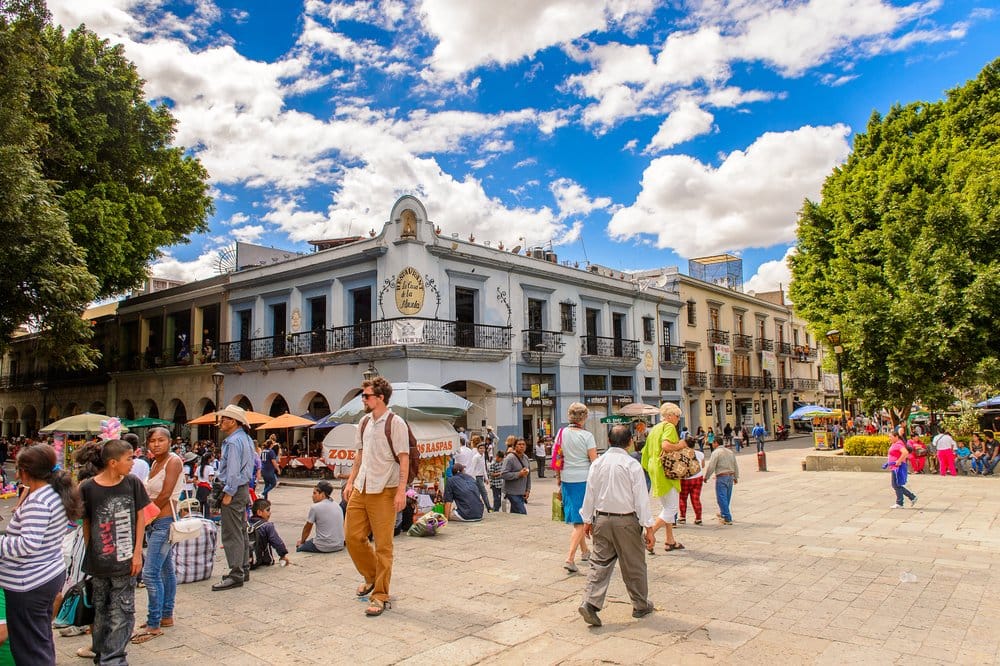
In the center of most Mexican cities, you can find the main square called “Zócalo.” And Oaxaca is no exception.
Around the Zócalo, you can visit many places to eat or have a drink while you continue your walk.
The Plaza de la Constitucion de la Ciudad de Oaxaca at the Zocalo has existed since 1529 and it was designed by Juan Pelaez de Berrio.
In this beautiful square, you can find different restaurants, street stalls, live music, and popular festivals held mainly on December 23rd, the night of Radishes, September 15th, the Fiesta of Independence, December 24th, and Christmas Eve, among other important festivities.
In the Zócalo of Oaxaca, you can stroll surrounded by monuments and important buildings such as the Benito Juárez portal, the Claverías portal, the former Government Palace, the Cathedral, and the Alameda de León.
Location: The Plaza de la Constitución (Zócalo) is located in the heart of the Historic Center of Oaxaca City, between the streets of Hidalgo, Trujano, Flores Magón and Bustamante.
2. Visit the Temple of Santo Domingo
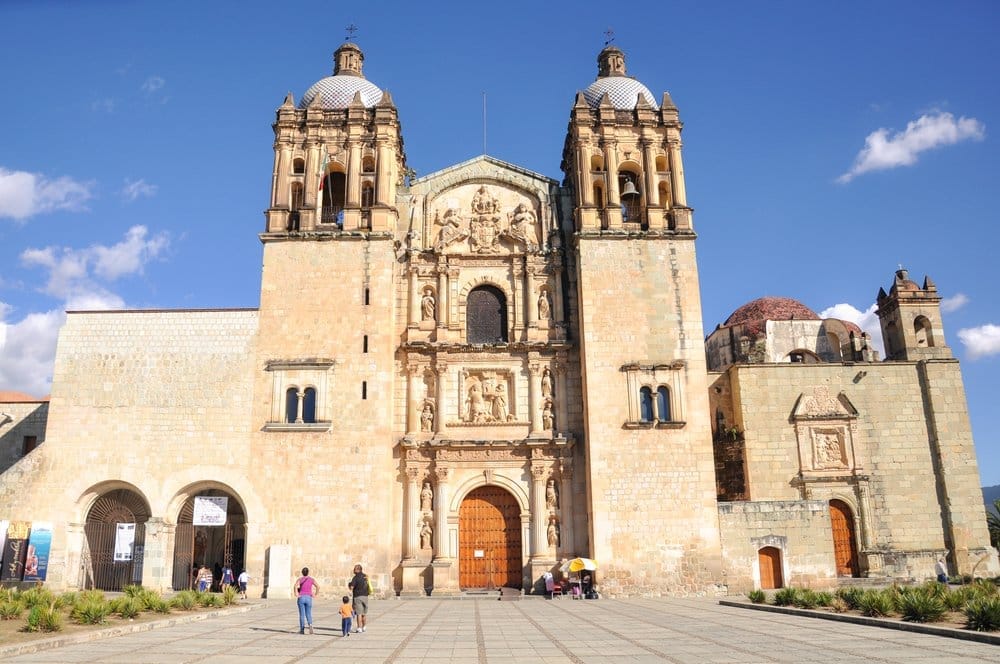
Due to the conquest of the Spaniards during the Colonial period, churches were the most built.
And in Oaxaca, you can see one of the most impressive ones in the country, the Templo de Santo Domingo, in the downtown district.
In 1933 it was declared a historical monument and although you can see it from the main square, be sure to enter the temple and admire the magnificent gilded interior.
The building has a lot of history as it has been used as a church, monastery, and even military barracks.
The Templo de Santo Domingo is a baroque catholic church from the 16th century, a beautiful building inside and out.
The temple’s decoration is one of the most impressive examples of Mexican Baroque; it includes a family tree of Santo Domingo de Guzman and 36 paintings located in the front illustrating passages from the Old Testament.
Location: The Temple of Santo Domingo is located just 6 blocks north of the Central Square (Zócalo) of Oaxaca City.
Hours: It’s open daily from 7 AM-1 PM and 4-8 PM except during private events.
If you visit on a Saturday, you will likely see some weddings.
3. Admire the Museum of Cultures
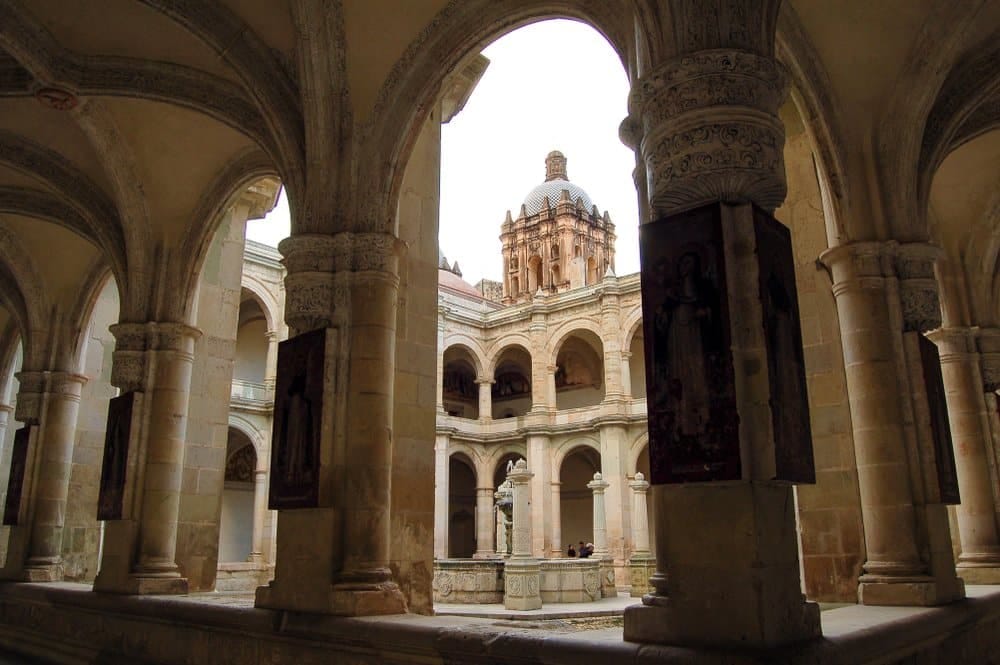
After you visit the Templo de Santo Domingo, I recommend visiting the Museo de las Culturas in Oaxaca City.
The museum is located in the building that used to be the convent of Santo Domingo de Guzmán, the largest and most important colonial construction still standing in Mexico and probably in all of the Americas.
In the precinct, you will find 13 different rooms with the following themes:
- Millenary Cultures (10000 B.C. – 200 A.D.)
- Times of Flourishing (200 – 900 A.D.)
- The Treasures of Tomb 7
- The Lordships (900 – 1521 A.D.)
- Spiritual Conquest of the Past (16th to 17th centuries)
- Indigenous Responses (16th to 18th centuries)
- Matter and Spirit (16th to 18th centuries)
- The emergence of the New Nation (late 18th – mid-19th centuries)
- Order and Progress (1876 – 1911)
- Images of the 20th Century
- Indigenous Communal Life (present time)
- Rebuilding the Community Circle (present time)
- Santo Domingo: History and Findings (16th – 20th centuries)
Between rooms 5 and 7, there are 13 interactive spaces where you can touch some elements and learn more information with multimedia and technology.
The most impressive display of all these rooms and exhibits is the Treasure of Tomb 7, a collection of precious stones and gold jewelry discovered in a large vault in Monte Alban.
You may want to read: Top 12 Pyramids and Ruins to Visit in Oaxaca in 2023
There is also an excellent view of the city inside the museum, making it well worth the MXN 70 (USD 3.5 approx.) entrance fee.
4. Visit the Children’s Museum of Oaxaca City
The Museo Infantil de Oaxaca MIO (formerly the Museo del Ferrocarril) is a former railroad station.
It features the MIO and the BS Ferrocarril Children’s Library and, an animal area, a pedal train, and restored cars where children can climb into and get up close to art, gastronomy, and even the chocolate-making process.
In the museum, there are playful activities through which children learn about popular art by identifying the work of the great artist Rodolfo Morales.
Other services offered by the museum are:
- Permanent workshops
- Special activities
- School visits for preschool and elementary school. Both shifts
- Pedal train tours
- Public events
Location: Antigua Estación del Ferrocarril, Francisco I. Madero 511, Del Ex-Marquesado, Oaxaca, Mexico.
Cost: $70 MXN ($3.5 USD approx.) entrance fee.
Hours: Open to the public from 10:00 a.m. to 7:00 p.m. Monday to Sunday.
5. Explore Monte Alban Oaxaca
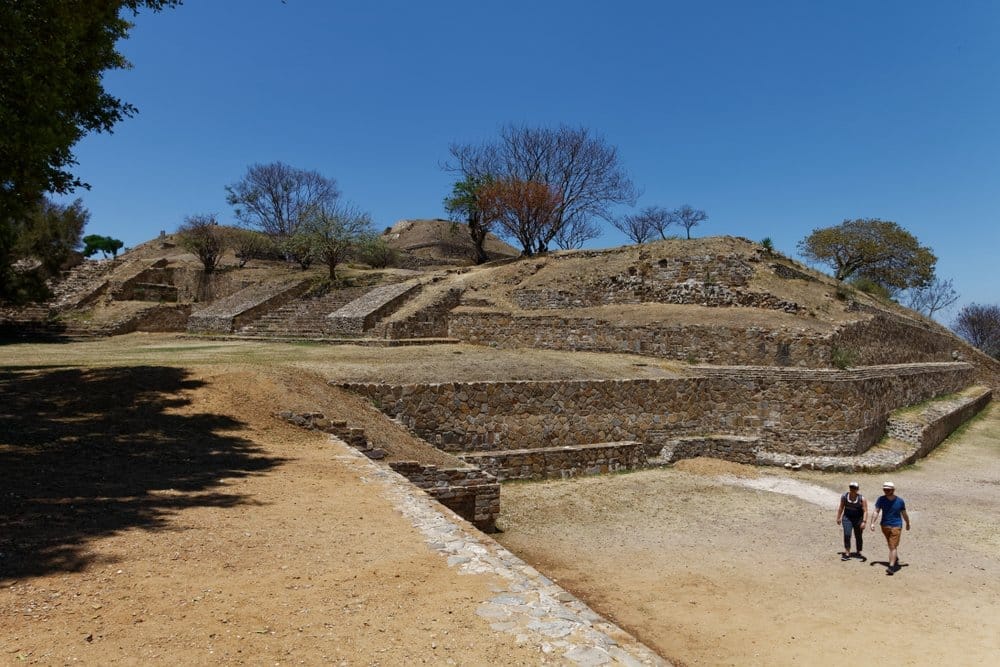
One of Oaxaca’s most popular tourist and activity sites is to take an excursion or a walk to the Ruins of Monte Alban (White Mountain).
In October 1987, it was declared a UNESCO World Heritage Site along with the city of Oaxaca.
The city of Monte Alban was built by the Zapotecs and is of great importance as it was the economic, political, and religious axis and the first urban complex in Mesoamerica.
The difference between the ruins of Monte Alban with other archeological sites such as Chichen Itza is that in Monte Alban, you can still climb the pyramids, which will allow you to enjoy spectacular views of the landscape.
To get to the site, you can take a bus, a cab, or even sign up for one of the many available tours accompanied by a group and guide.
The Archeological site has an on-site museum, cafeteria, restaurants, restrooms, publications, jewelry, handicrafts, rest areas, and guided tours.
6. Visit the Ethnobotanical Garden
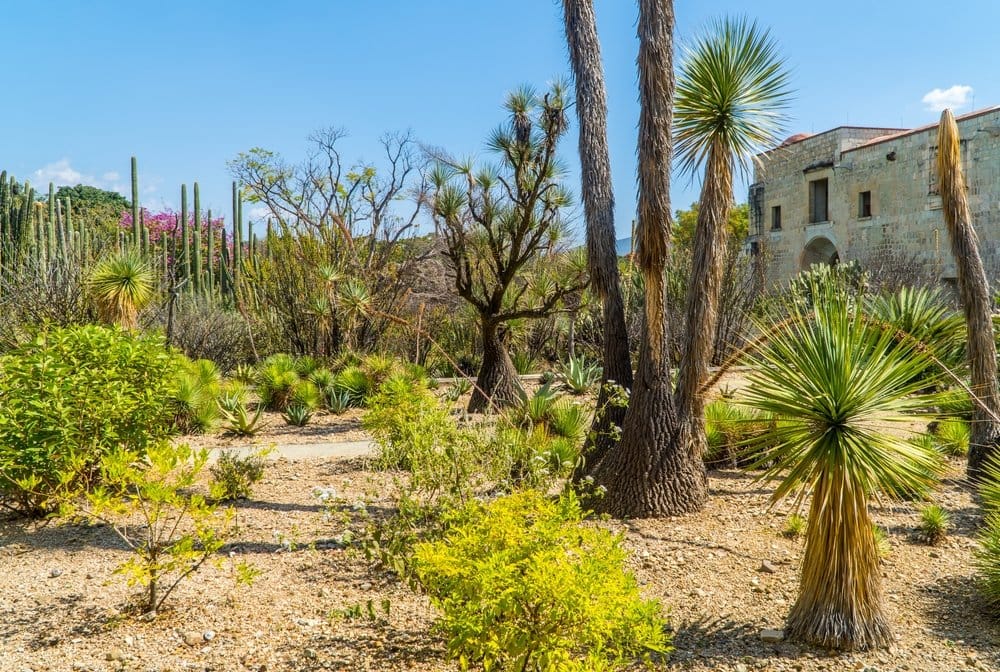
The Ethnobotanical Garden is part of the Santo Domingo Cultural Center in the former convent built in the 16th and 17th centuries by the Dominican friars.
The garden was part of the old convent orchard and is now a space where you can find hundreds of plant species all native to Oaxaca.
These plants come from areas of the state with arid and humid climates and tropical and mountainous areas.
Being part of the Santo Domingo Cultural Center in Oaxaca, the cathedral and the culture museum are other places you can visit on the same grounds.
You can find tours for MXN 100 (USD 5 approx). There are tours and guided tours in Spanish, English, French, and German.
Location: Oaxaca’s main Zocalo.
Hours: Monday to Saturday. 10:00, 12:00, and 17:00.
Cost per person: $50 (Free for children from 0 to 12 years old).
Duration: one hour.
7. Hiking and swimming in Hierve el Agua
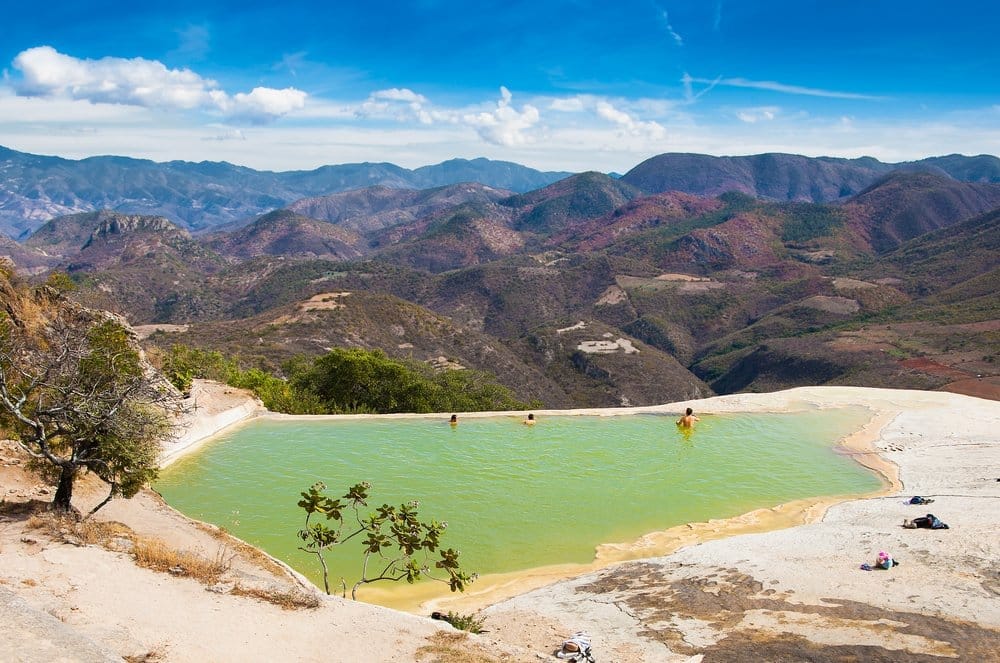
When you travel to Oaxaca, an excursion to the Hierve el Agua Park is a must.
In Hierve el Agua, you can spend half a day hiking and enjoying nature’s breathtaking views.
In this great natural place, you can admire and take a dip in the waters of the mineral springs.
Although its name translates to “Boiling Water,” don’t worry, it is not hot but quite cold.
The impressive thing about the waterfalls of Hierve el Agua is that they are petrified.
Location: Hierve el Agua is located next to the village of Roaguía, 5 km from San Lorenzo Albarrada. Approximately 70 km (1:30 hrs) from Oaxaca city.
8. Visit the ruins of Mitla
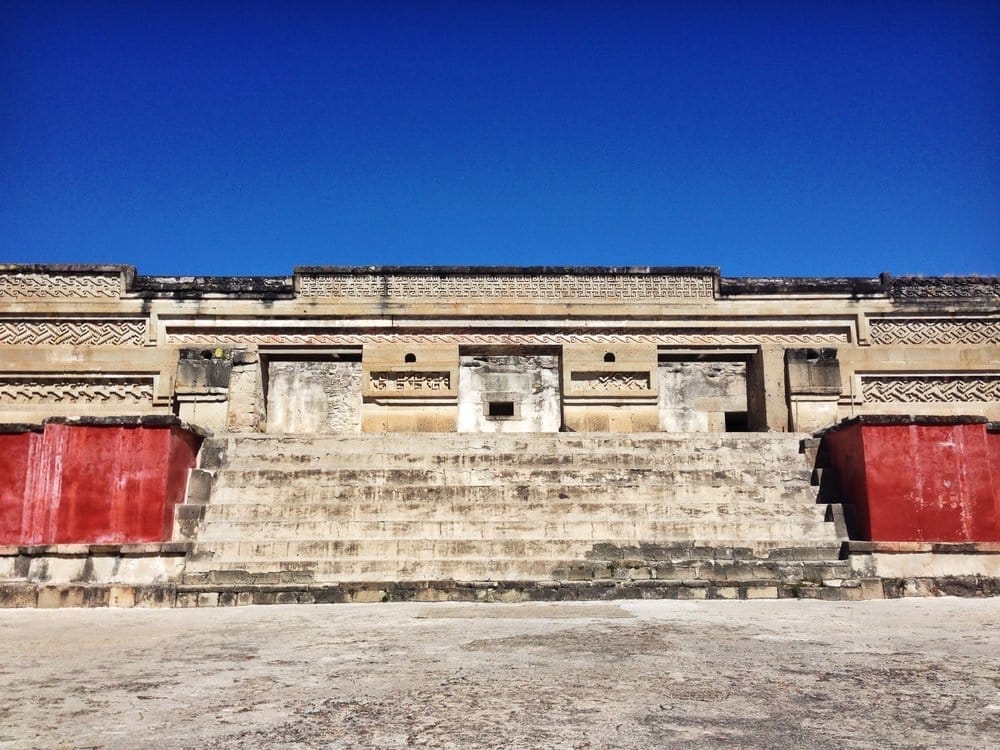
If you take a tour of Hierve el Agua, you can also visit the Mitla Ruins.
These were the religious center of the Zapotecs, and the name “Mitla” comes from the Nahuatl word meaning place of the dead or the underworld.
This is definitely one of the things you have to do in Oaxaca.
The ruins of Mitla are popular because of the Column of Life located in the tombs.
It is said that if you wrap your arms around the column, the space between your hands represents how many years you have left on Earth.
Day of the Dead Festivities
If you are looking for a traditional and magical place to celebrate the Day of the Dead in Mexico, you must experience Oaxaca.
The city is home to some of the most lively and traditional Day of the Dead celebrations, from late October to early November.
Believe it or not, the Day of the Dead is not a mourning holiday but a celebration of life.
Locals and tourists visit cemeteries to decorate graves and loved ones, and allegorical parades are held.
This is one of the most important festivities in Mexico. Although it is celebrated in different parts of the country, there is no other city like Oaxaca to enjoy it fully.
Experience the Guelaguetza Festival

Another party you have to enjoy in Oaxaca is the annual Guelaguetza festival.
It is a combination of traditional dance performances by local indigenous groups.
The festivities are held yearly on the last two Mondays of July in a beautiful outdoor amphitheater.
The Guelaguetza festivities have their origins in colonial times. They are related to the Corpus Christi feast of the Iglesia del Carmen Alto, a temple built by the Carmelitas on the slopes of a hill called Bella Vista.
The Fiestas del Lunes del Cerro take place throughout July with folkloric presentations, concerts, exhibitions, cultural and sporting events, the most outstanding of which are:
- The Guelaguetza (Guelaguetza Auditorium)
- The Parade of the Delegations
- The Legend of the Princess Donají
- The Mezcal and Gastronomic Fair
- As well as many other events and activities in and around the city
Being one of Mexico’s most important and popular festivals, you must buy your tickets well in advance. Remember – The festivities are held yearly on the last two Mondays of July.
Visit the MACO Museum of Contemporary Art in Oaxaca
The MACO Museum of Contemporary Art in Oaxaca is located in an old mansion supposedly owned by the conquistador Hernán Cortés.
The house dates from the 17th and early 18th centuries and is one of the most significant buildings in Oaxaca’s civil architecture of the viceregal era.
In 1986 the state government acquired it to create the Museum of the City, and it was not until 1992 that it was inaugurated as the MACO Museum of Contemporary Art.
You will find a national and international contemporary plastic art exhibition with paintings, sculptures, graphic works, and photographs in this cultural space.
The museum has 16 exhibition rooms, a store, guided tours, courses, and workshops.
Location: Macedonio Alcalá 202 Centro CP 68000 Oaxaca De Juárez, Oaxaca de Juárez, Oaxaca.
Hours: MACO is open Wednesday through Monday from 10:30 am to 8 pm.
Cost: General admission MXN 20 – Sunday admission is free
Take a walking tour
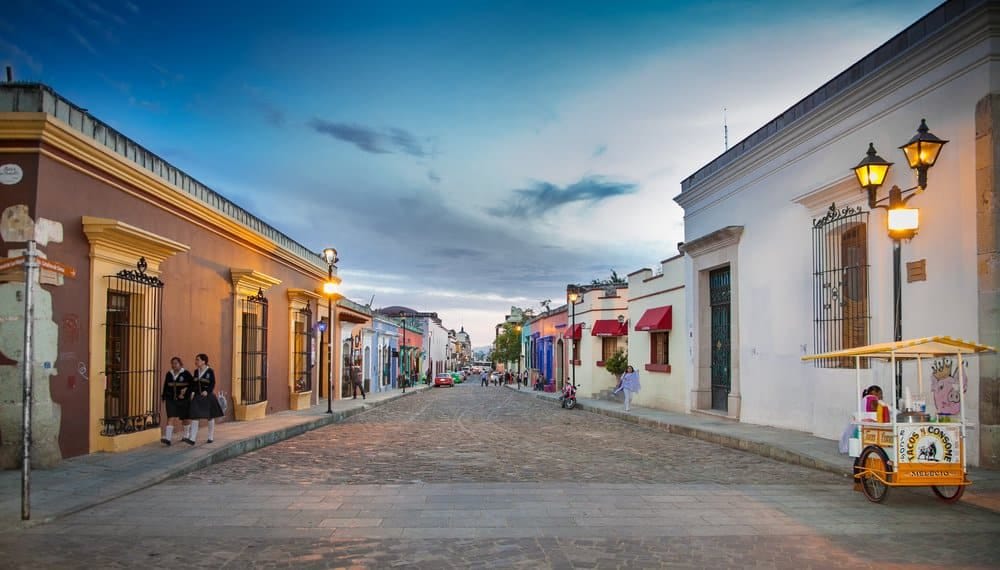
As in many other cities worldwide, you can take a free walking tour, and Oaxaca city is no exception.
This way you will learn much about the city, its history, and culture guided by a local expert.
The best part is you will also make new friends along the way.
These tours usually start at 10 am in front of the Oaxaca Cathedral and last approximately two hours.
Get lost in Oaxaca’s different markets
Another thing you have to do when you visit Oaxaca is to explore the numerous city markets.
You will find delicious local food at the best prices in these wonderful markets and lots of interesting souvenirs and mementos.
One of the most popular is the Benito Juarez market, where you can try typical Oaxacan dishes such as mole, cheese, crickets, and mezcal.
The markets are an essential part of our culture for Mexicans, so you will love to visit them.
Rufino Tamayo Museum Oaxaca
Also known as the Museum of Pre-Hispanic Art of Mexico. It was created by the famous painter Rufino Tamayo himself, and one of its objectives is to show the painter’s sources of inspiration.
It is located in an old colonial mansion that Rufino Tamayo had restored and turned into an important museum.
The works inside the museum are distributed in 5 rooms, and the place also hosts concerts, courses, lectures, presentations, and other events that help promote the culture of Oaxaca.
Location: Morelos No. 503, Downtown
Hours: The Rufino Tamayo Museum of Prehispanic Art of Mexico is open every day except Tuesdays from 10:00 to 14.00 and from 16:00 to 19:00. Sundays from 10:00 to 15:00 hours.
Cost: $40 MXN ($2 USD)
Enjoy the night of Radishes in Oaxaca City
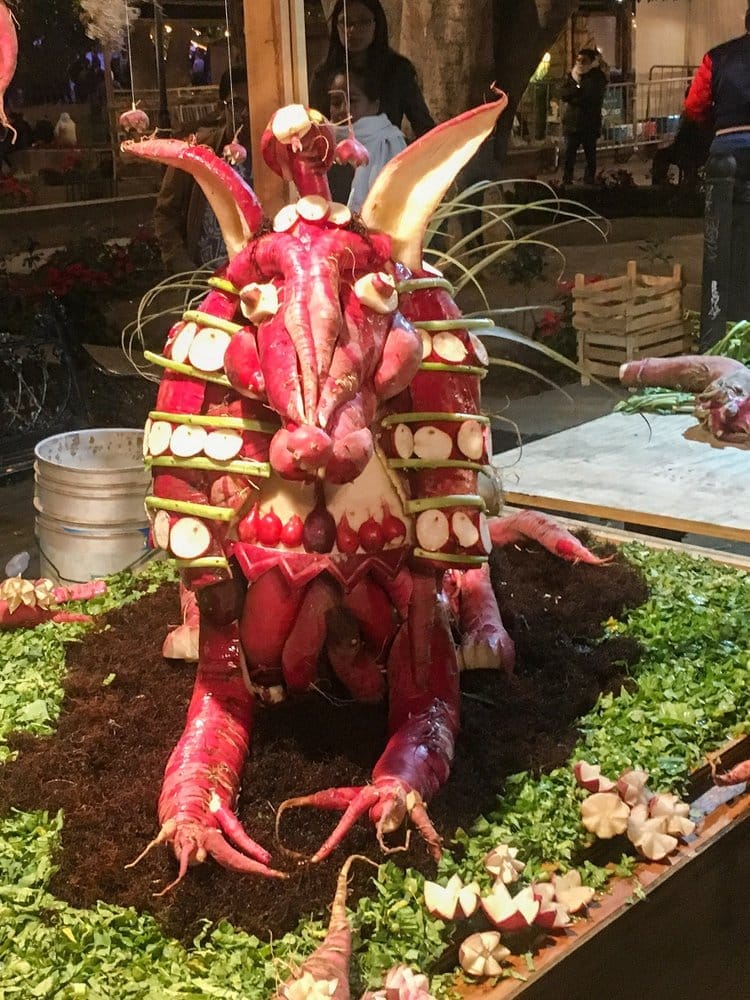
The Noche de Rábanos is a popular festival celebrated on December 23rd in Oaxaca.
Special designs made with radishes, immortal flowers, and totomoxtle are exhibited during the party.
The festival lasts only a few hours in the city’s Zocalo. It is said that the first radish night was held in 1897.
After the first contest in 1897, it has been held year after year ever since. And although the stars of the night are the radishes, in recent years, new categories have been added to the contest: the immortal flower and the totomoxtle.
If you happen to be in Oaxaca, you must live the experience and enjoy the wonderful displays you will see in the parade.
Participate in a Oaxacan Temazcal Ceremony
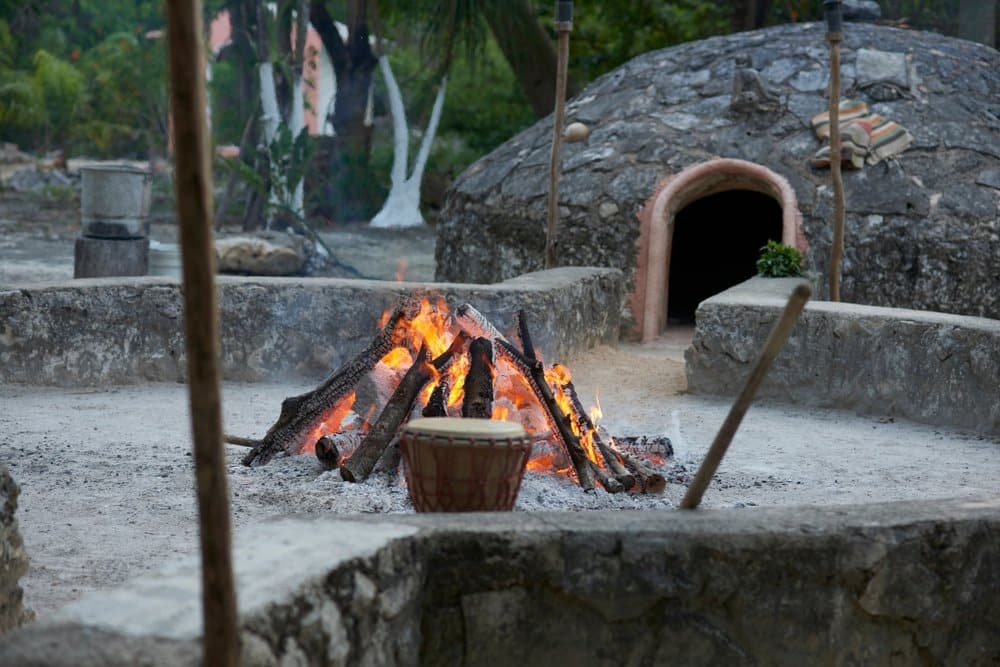
You can’t leave Oaxaca without experiencing a “temazcal ceremony.” This is one of the many interesting things to do in Oaxaca.
Temazcal is an ancient Mayan ritual that helps you eliminate toxins through your body’s sweat.
Once you have found the place inside, the ritual begins. Chanting and drumming fill the air and inject energy into the space.
The shaman then guides you to rub tangerine and orange halves over your skin like soap.
All the while pouring more water over the steaming volcanic rocks. The heat rises, and the energy intensifies.
You’ll continually focus on breathing and cool the air through the mouth before reaching your lungs.
The Shaman brings herbs, oils, mezcal, and other ointments during the different stages of the experience to rub on certain points of your body for different beneficial reasons.
They also explain each stage and its meaning while pouring more water and aromatic mixtures on the rocks, increasing the heat.
The ceremony lasts up to an hour and a half or so. After leaving the Temazcal and entering the light, you will feel attuned to the sounds, sights, and breeze of the environment around you.
The goal is to leave with more knowledge, free of doubts, and full of energy.
Admire the street art of Oaxaca City
You will find different street art exhibits all over Mexico; this southern state is no exception.
Walking around, you will be able to admire a great variety of street art that you will find incredible, all the result of the street artist known as Lapiztola.
The goal of this artistic movement is to use art to spread social and political messages. But no matter what the movement was created for, the important thing is that you can enjoy admiring the murals.
Pedestrians only
When walking between the Zócalo and the Templo de Santo Domingo, you can use the pedestrian-friendly Calle Alcalá.
What makes this street special is that it is a pedestrian-only street. That’s right, there are no cars, so it is very comfortable to walk along with it.
This way, you can admire colonial buildings, galleries, cafes, craft stores, and bars.
If you spend a few days in Oaxaca, chances are you will return to Calle Alcalá at least a few times – the traffic in Oaxaca City can be relentless.
It’s always nice to get away from the fumes of vehicles and enjoy a stroll through the city.
Enjoy a delicious steak at the Mercado 20 de Noviembre
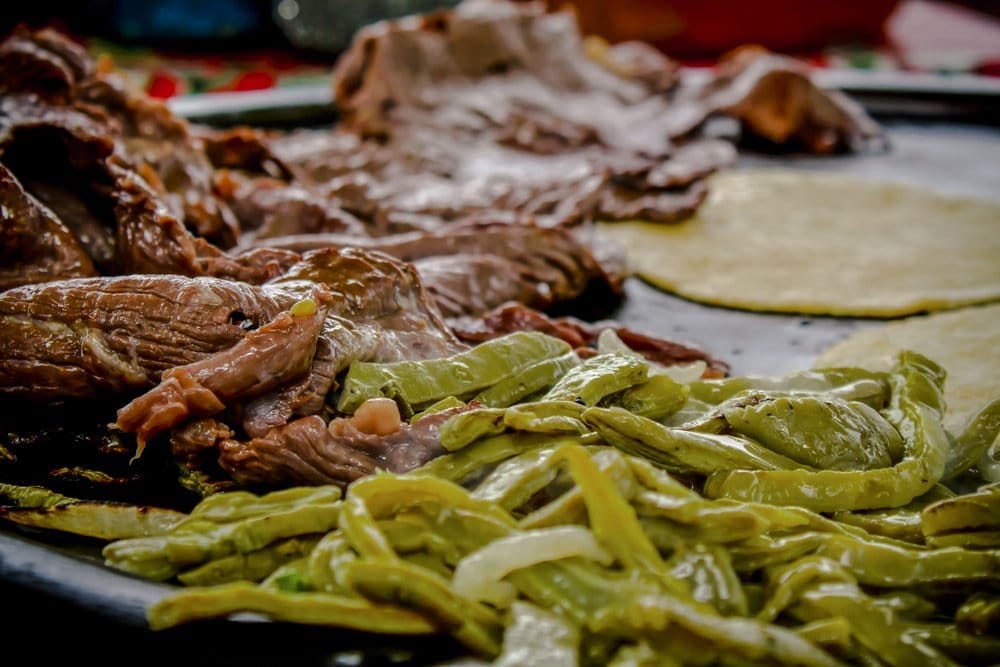
If you enjoy meat as I do, this is the best place to visit in Oaxaca!
But, even if you are a vegetarian, you can still find some foods you enjoy. The Mercado 20 de Noviembre is like a meat hall.
It is a trendy place for locals and tourists alike. If you’re unsure where it is, follow the smell of grilled steak…..
Basically, you choose the vegetables you want to grill and then take your tray to the “meat man,” who will add protein to your tray (try thinly sliced beef, sausage, or ribs).
You’ll get a number, and until your name is called, sit at one of the tables – shared seating style. Tortillas and condiments will come for you to choose from.
This market is where the locals eat, so you can enjoy a cultural experience and maybe make new friends over a barbecue – this is one of the most delicious things to do in Oaxaca, well worth it!
Fiesta with local food
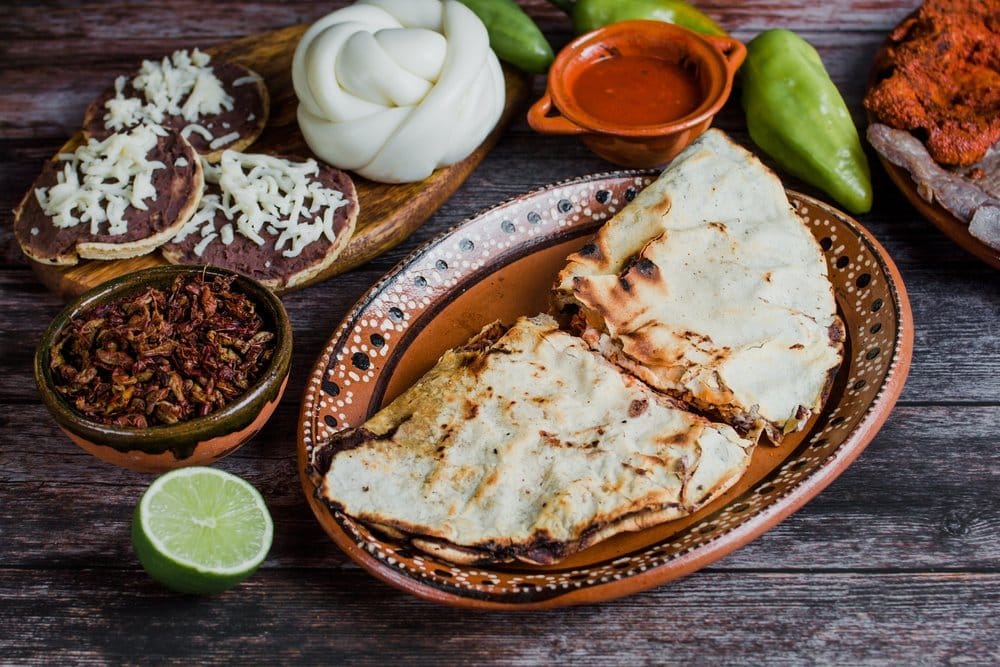
Ask any Mexican what you should do in Oaxaca, and most will answer, “Eat!”. Indeed, Oaxaca is famous for its mouth-watering cuisine, and you’ll have to indulge your taste buds while you’re there.
Each Mexican region has its own traditional cuisine on offer, and the same goes for Oaxaca City.
Perhaps the most representative local dish is the tlayuda – a crispy, lightly fried tortilla topped with beans, meat, lettuce, avocado, salsa, and local cheese (soft, white, and very stringy).
Mole sauce is also said to have originated right here in Oaxaca, so you’ll have to try the different varieties (there are 7!).
Take a Mexican cooking class
Since you’re going to be enjoying delicious food, you might as well learn how to make it at home.
There are several different options for Mexican cooking classes in the city, so sign up and discover your inner chef.
Try Oaxacan mezcal

Another must-do in Oaxaca is to try the mezcal they prepare at different spots around the city. This spirit is made from any agave plant, unlike tequila which can only be made from blue agave.
Mezcal has a unique smoky flavor thanks to the underground pits that roast the plant. Learn more about Mexican Spirits.
As you may already know, Oaxaca is known for producing some of the best mezcals in the country, so you have to go to one of the countless mezcalerías and try some.
Chances are you’ll love it so much you’ll want to grab a bottle to bring back home.
Visit the Oaxaca market on Sunday
If you happen to be in Oaxaca on a Sunday, then you’ll be lucky enough to visit the massive Tlacolula market.
Here you will find vendors coming from all over the valley to sell a wide variety of products.
It is a great place to observe how these people dress, as most of them wear the traditional clothing of their village.
Strolling through the market, you can buy a wide variety of fresh produce, taste delicious street food, drink mezcal and buy handmade products.
You have to experience the vibrant atmosphere that can be felt in the Tlacolula market.
Get some Alebrijes in Arrazola
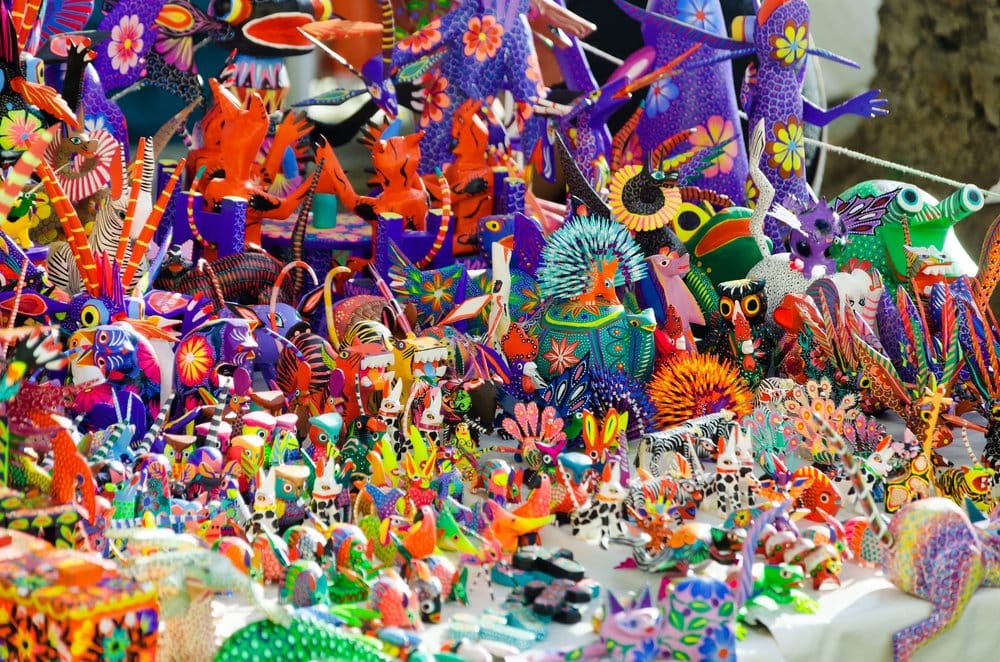
In Oaxaca, you can also find Alebrijes in San Antonio Arrazola.
This town is famous for its alebrijes made of tzompantli, copal, or copalillo; you will love them!
Admire the Alameda de Leon in Oaxaca
Last but not least is the Alameda de León in downtown Oaxaca City.
The Alameda is dedicated to Don Antonio de León Benemérito de Oaxaca, who was Governor of the State and a military man who participated in the independence of Mexico.
The place was inaugurated in October 1843 and was recently remodeled to give it a more urban touch, typical of a historic city. It is located right next to the city’s Zócalo.
So if you are strolling in the main square, don’t forget to visit La Alameda.
Oaxaca City: Conclusion
In conclusion, Oaxaca City stands as a vibrant tapestry of culture, history, and natural beauty, inviting travelers from around the globe to immerse themselves in its rich tapestry.
From the awe-inspiring archaeological sites of Monte Albán and Mitla to the bustling markets teeming with artisanal crafts and flavorsome delicacies, every corner of this enchanting city offers a glimpse into Mexico’s diverse heritage.
Whether you’re strolling through the cobblestone streets of the historic center or marveling at the intricate craftsmanship of Oaxacan textiles, each experience promises to be as unforgettable as it is enriching.
So, pack your bags, set out on an adventure, and let Oaxaca City captivate your senses and ignite your wanderlust like never before.